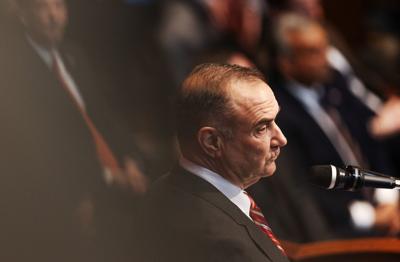
Missouri Gov. Mike Kehoe delivers his first State of the State address on Tuesday, Jan. 28, 2025, at the Missouri Capitol in Jefferson City. Kehoe called for dramatic changes in the state's education system and called on legislatures to approve bills that would place the ├█č┐┤½├Į Metropolitan Police Department under state control.
JEFFERSON CITY ŌĆö Gov. Mike Kehoe has already sold lawmakers on a long-discussed state takeover of the ├█č┐┤½├Į Metropolitan Police Department.
Now, with lawmakers returning Monday from a weeklong spring break, the former car dealer is trying to move the rest of his first-year agenda.
Two school-choice priorities remain on the new Republican governorŌĆÖs to-do list: an open-enrollment plan for public school students, along with an unprecedented $50 million in direct spending for the stateŌĆÖs private school voucher program known as MOScholars.
So far this session, some Senate Republicans have raised questions about the spending on MOScholars. And nearly two-dozen House Republicans voted against the open-enrollment plan on March 12 when it was sent to the Senate.
People are also reading…
The open enrollment plan aims to allow public school students to transfer to districts where they donŌĆÖt reside. Direct state spending on private schooling costs, meanwhile, is a long-term goal for school-choice proponents.
First passed in 2021, MissouriŌĆÖs MOScholars program currently to qualified students for the current school year. It runs off of private donations that are eligible for tax credits.
KehoeŌĆÖs active approach to legislating could help boost both priority items.
At a news conference earlier this month, Kehoe credited legislative leaders for their willingness to figure out how to solve problems as opposed to having meetings and trying to do things ŌĆ£that never produce results.ŌĆØ
ŌĆ£IŌĆÖm a small business guy and I want results produced,ŌĆØ Kehoe said.
KehoeŌĆÖs approach stands in contrast to that of his predecessor and ally, Republican Gov. Mike Parson, who often declined to comment publicly on ongoing legislative efforts.
ŌĆ£ItŌĆÖs not unusual to see him (Kehoe) in the Capitol walking the halls and talking to people,ŌĆØ Rep. Dean Van Schoiack, R-Savannah, in northwest Missouri. ŌĆ£It was unusual to see Governor Parson doing that.ŌĆØ
Van Schoiack said Kehoe was more accessible than Parson.
ŌĆ£He goes down and gets lunch with everybody else at the cafeteria,ŌĆØ Van Schoiack said.
Fights coming to a head
With the House advancing the open-enrollment plan on an 88-69 vote, the measure now awaits action in the Missouri Senate, where it has died for the last four years.
Separately, the House has yet to vote on the fiscal 2026 budget blueprint, which contains the direct spending on the MOScholars program.
After House approval, the budget will move to the Senate, where Appropriations Chair Lincoln Hough, R-Springfield, has already questioned the $50 million outlay.
While KehoeŌĆÖs budget plan devotes $50 million to MOScholars, his proposal shorts the Department of Elementary and Secondary Education roughly $300 million in requested funding.
Democrats have taken note, blasting the funding for private school at a time when the state isnŌĆÖt meeting public school funding obligations.
ŌĆ£They can find $50 million to subsidize rich parents sending their kids to private school but they canŌĆÖt find the 300 million that is state law to fund our (public) schools,ŌĆØ Senate Minority Leader Doug Beck, D-south ├█č┐┤½├Į County, said in January.
Kehoe, for his part, has taken part in a six-figure ad campaign by the pro-school choice American Federation for Children to promote the $50 million expenditure.
The American Federation for Children announced in February an ad featuring Kehoe would play on cable and streaming services.
ŌĆ£I was raised by a single mother, and I watched her struggle to put me through a private school because it was the best learning environment for me,ŌĆØ said Kehoe, who graduated from Chaminade College Preparatory School in 1979.
ŌĆ£Now, I want to help all Missouri parents provide the education that meets every childŌĆÖs individual learning needs,ŌĆØ he says in the ad.
Tax cuts and more pending
A host of other issues remain unresolved in the second half of the legislative session. The 4┬Į-month session ends May 16.
A sweeping tax cut proposal that could cost the stateŌĆÖs general coffers over $1.2 billion annually in a decade awaits action in the Senate after clearing the House before spring break.
The package currently would cut the stateŌĆÖs income tax, eliminate capital gains taxes, slash the corporate income tax rate, and increase tax benefits for donations to pregnancy resource centers, maternity homes and diaper banks.
The House-passed proposal could be pared back in the Senate. Kehoe, in his State of the State, called for income tax reductions.
Kehoe also called for legislators to approve ŌĆ£substantial tort reformŌĆØ in his late January State of the State address, but didnŌĆÖt specify what reforms he wanted.
Legislation to shield Bayer from failure-to-warn lawsuits connected to its glyphosate weedkiller passed the House in February, but a group of nine Senate Republicans has declared the House bill ŌĆ£dead on arrivalŌĆØ in the upper chamber.
Some Republicans have also called for a ballot question to enact abortion restrictions following passage of the abortion-rights Amendment 3 last year.
Kehoe didnŌĆÖt call for that in his State of the State address, instead advocating for more money for alternatives to abortion. Proposed ballot questions on abortion havenŌĆÖt gained significant traction so far this legislative session.
And, a House-approved plan to repeal sick leave requirements voters approved last year, as well as roll back future inflation-based minimum wage increases, awaits action in the Senate.
Proposition A, containing the new law, was approved by 57% of voters in November.
That measure passed the House before spring break. Opponents are looking to stymie a requirement in the new law that will allow workers to begin accruing paid sick leave starting May 1.
Missouri Governor Mike Kehoe addressed plans to ŌĆ£secure MissouriŌĆÖs futureŌĆØ through improving public safety, education and reducing the role of government.














